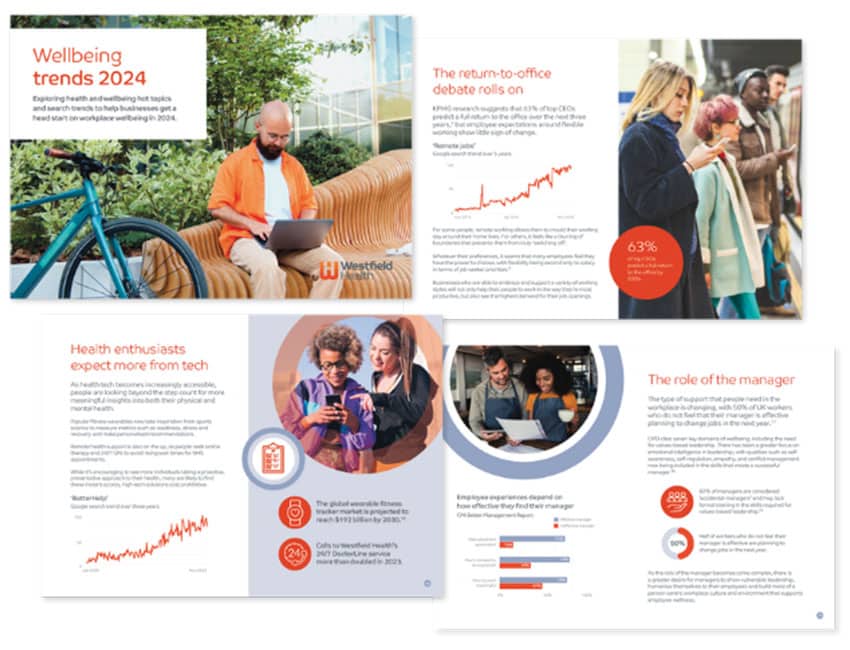With the line between our work and home lives remaining blurred, it’s not uncommon for office small-talk to include the latest trends in everything from vitamin supplements to cold water therapy. But is there a place for these wellness trends at work?
In 2024, almost half of consumers — and especially Gen-Z — now use TikTok as a search engine, and it’s easier than ever to find ourselves swept up in wellbeing trends and health hacks.
The rise of influencers and short-form video reels make it difficult for consumers to access the research that distinguishes tried-and-tested health habits from ineffective fads. And the impact of this could be huge — not only to individuals but also to the health of our workplaces.
The UK’s sickness absence rate is at a 20-year high, posing a challenge not only for the NHS but also for HR and wellbeing teams who are looking to provide support for employees in their organisation. While it may seem obvious that ice baths and office nap pods aren’t the solution to long-term health issues, what place — if any — do these growing trends have in the workplace?
How should HR engage with wellness trends at work?
If employees are interested in wellness trends, they’re probably looking to make small changes to their habits to help improve their health. While TikTok fads may be fleeting, they can be used to open the conversation and help employees to engage with their health in a more meaningful way. For HR and wellbeing professionals, this is an opportunity to engage your people with the wellbeing support on offer in the workplace.
Despite the allure of ‘health hacks’, rushing into large investments — whether that’s an office ice bath, a suite of nap pods or the latest gym kit — is unlikely to have a lasting impact on employee health.
While it can be inspiring to read about the facilities on offer at cutting edge corporate offices, it’s important to build a solid foundation of support (and a positive culture to reinforce it) before trialling new and novel wellness trends at work.
At its core, a successful workplace wellbeing strategy should provide reliable, evidence-based support that’s tailored to the unique needs of the business and its employees. From there, innovation and experimentation can grow.
Building an evidence-backed wellbeing programme
While few businesses have the budget to jump on board with every passing trend, HR teams can find it tricky to win investment in evidence-based wellbeing options too. If you’re trying to make the case for meaningful wellbeing support, try these tips to help you make the most of your data and insight:
Draw on existing wellbeing research and choose tried and tested solutions before exploring more experimental options.
Employees are likely to value wellbeing-focused policies such as flexible or hybrid working, plus health support such as health insurance, health cash plans and mental health support, including access to counselling. Generally, these should take priority over new or unproven wellbeing solutions — especially if you’re looking to make an impact on a tight budget.
Measure the impact of your wellbeing spend to demonstrate its value and know when to make changes to your approach.
If you’re struggling to get buy-in or budget, our free CPD-accredited Wellbeing Strategy course is a good place to start. This one-hour online training module for HR teams and wellbeing managers explores how to choose effective health and wellbeing solutions and demonstrate their impact to your leadership team.
Collect regular feedback on your wellbeing offering to prioritise the support people really need.
Your wellbeing strategy should include a feedback loop to ensure employee voices are heard and acted on, whether that’s through focus groups, pulse surveys or even just a chat over coffee. We’ve put together a downloadable pack of sample wellbeing survey questions to help you start the conversation.
What wellbeing trends will we see in 2024?
If you want to find out more about upcoming trends and topics in workplace wellbeing, check our Wellbeing Trends 2024 report.
View our wellbeing trends webpage
It covers key emerging trends — including hybrid working, loneliness, health technology and wellness trends at work — to help HR teams and wellbeing managers stay on top of new developments and prioritise their business’ wellbeing support.
